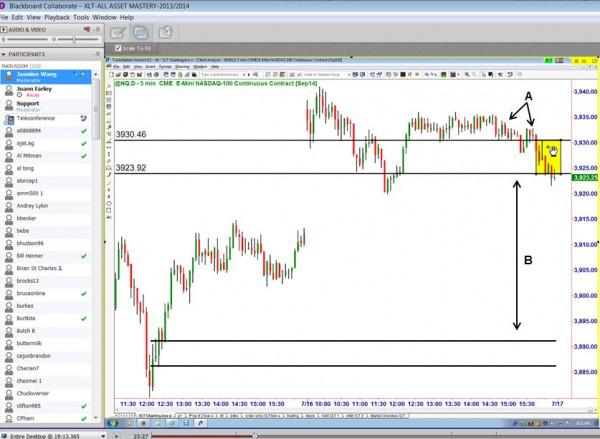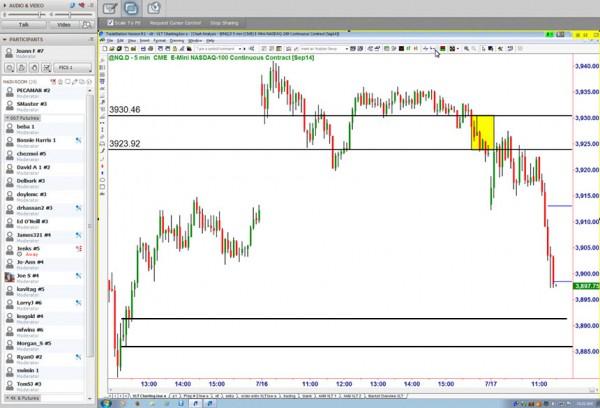![]()
The Path of Least Resistance
When an object is in motion, the range of that motion is typically very clear. Take a ball for example. If I am standing in a room and I throw the ball up to the ceiling, I know it will hit the ceiling and fall to the floor. If the ceiling is 10ft high and I throw the ball up from a height of 5ft, it will rise 5ft and fall 10ft. I think it’s reasonable for me to assume we can all agree with this scenario. We can all agree because we all understand gravity and can see the floor and ceiling. The key is the word “see.” Imagine if you could “see” the floor and the ceiling in market prices with a very high degree of accuracy. Exploring this using an Extended Learning Track (XLT) trading opportunity from last week is the focus of this piece.
At home, you may have a hard wood floor and a ceiling made of dry wall or some fancy wood. In the markets, the floor and ceiling are simply demand and supply or in simple terms, unfilled buy and sell orders. Figuring out where price is going to turn and where it is going to go is not that hard if you know what you’re looking for on the chart.
Live Trading Room Trade Setup: NASDAQ – 7/17/14
During a live trading session with our students in the XLT, an opportunity arose in the NASDAQ Futures. Price was basing sideways, not really moving up or down that much in the yellow box area. Where was it likely to move from that level? Think of the ceiling and the floor… Where are the unfilled buy (floor) and sell (ceiling) orders? Our “A” on the chart is a price level where when price was trading at that level, it could not remain there. It fell from that level simply because supply exceeded demand at that level. Once the last buy order was filled at that level, there were still sell orders left and when that equation is present, price always has to decline and it did. So, while I would never call area “A” a significant supply level, there were some unfilled sell orders in that area which is why price declined and started basing in that yellow shaded range. Next, where would price move from there? Well, so far we know that we have some supply (ceiling, “A”) above. We also know that the chart is telling us the demand (floor) is much lower. “B” represents the distance between demand and supply, the floor and the ceiling. There is no price action in the range labeled “B” that represents demand so we would expect price to move down through that level. The screen shot is from the live session; that’s what the chart looked like in real time for our XLT students. So, once we know where the floor and ceiling is, we can play ball or if you are trading the financial markets, we can place trades, the logic and equation is the exact same.
Live Trading Room Trade Result: NASDAQ – 7/17/14
Once you have all the information you need, it’s time to execute your plan with no thinking or emotion involved. Once price declined from that level as expected, it rallied back to the supply level (yellow box) and proceeded to decline and reach the profit targets we had for this trade (blue lines). Notice price declined rather quickly through that area. It did this because there was simply no floor (demand) to stop it. Your confidence in bouncing a ball is there because you can see the floor and ceiling. You can also see the buy (demand/floor) and sell (supply/ceiling) orders on a price chart in any market and time frame if you know what you’re looking for.
Hope this was helpful. Have a great day.
Note: All information on this page is subject to change. The use of this website constitutes acceptance of our user agreement. Please read our privacy policy and legal disclaimer. Opinions expressed at FXstreet.com are those of the individual authors and do not necessarily represent the opinion of FXstreet.com or its management. Risk Disclosure: Trading foreign exchange on margin carries a high level of risk, and may not be suitable for all investors. The high degree of leverage can work against you as well as for you. Before deciding to invest in foreign exchange you should carefully consider your investment objectives, level of experience, and risk appetite. The possibility exists that you could sustain a loss of some or all of your initial investment and therefore you should not invest money that you cannot afford to lose. You should be aware of all the risks associated with foreign exchange trading, and seek advice from an independent financial advisor if you have any doubts.
Editors’ Picks
EUR/USD edges lower toward 1.0700 post-US PCE

EUR/USD stays under modest bearish pressure but manages to hold above 1.0700 in the American session on Friday. The US Dollar (USD) gathers strength against its rivals after the stronger-than-forecast PCE inflation data, not allowing the pair to gain traction.
GBP/USD retreats to 1.2500 on renewed USD strength

GBP/USD lost its traction and turned negative on the day near 1.2500. Following the stronger-than-expected PCE inflation readings from the US, the USD stays resilient and makes it difficult for the pair to gather recovery momentum.
Gold struggles to hold above $2,350 following US inflation

Gold turned south and declined toward $2,340, erasing a large portion of its daily gains, as the USD benefited from PCE inflation data. The benchmark 10-year US yield, however, stays in negative territory and helps XAU/USD limit its losses.
Bitcoin Weekly Forecast: BTC’s next breakout could propel it to $80,000 Premium

Bitcoin’s recent price consolidation could be nearing its end as technical indicators and on-chain metrics suggest a potential upward breakout. However, this move would not be straightforward and could punish impatient investors.
Week ahead – Hawkish risk as Fed and NFP on tap, Eurozone data eyed too

Fed meets on Wednesday as US inflation stays elevated. Will Friday’s jobs report bring relief or more angst for the markets? Eurozone flash GDP and CPI numbers in focus for the Euro.
RECOMMENDED LESSONS
Making money in forex is easy if you know how the bankers trade!
Discover how to make money in forex is easy if you know how the bankers trade!
5 Forex News Events You Need To Know
In the fast moving world of currency markets, it is extremely important for new traders to know the list of important forex news...
Top 10 Chart Patterns Every Trader Should Know
Chart patterns are one of the most effective trading tools for a trader. They are pure price-action, and form on the basis of underlying buying and...
7 Ways to Avoid Forex Scams
The forex industry is recently seeing more and more scams. Here are 7 ways to avoid losing your money in such scams: Forex scams are becoming frequent. Michael Greenberg reports on luxurious expenses, including a submarine bought from the money taken from forex traders. Here’s another report of a forex fraud. So, how can we avoid falling in such forex scams?
What Are the 10 Fatal Mistakes Traders Make
Trading is exciting. Trading is hard. Trading is extremely hard. Some say that it takes more than 10,000 hours to master. Others believe that trading is the way to quick riches. They might be both wrong. What is important to know that no matter how experienced you are, mistakes will be part of the trading process.


